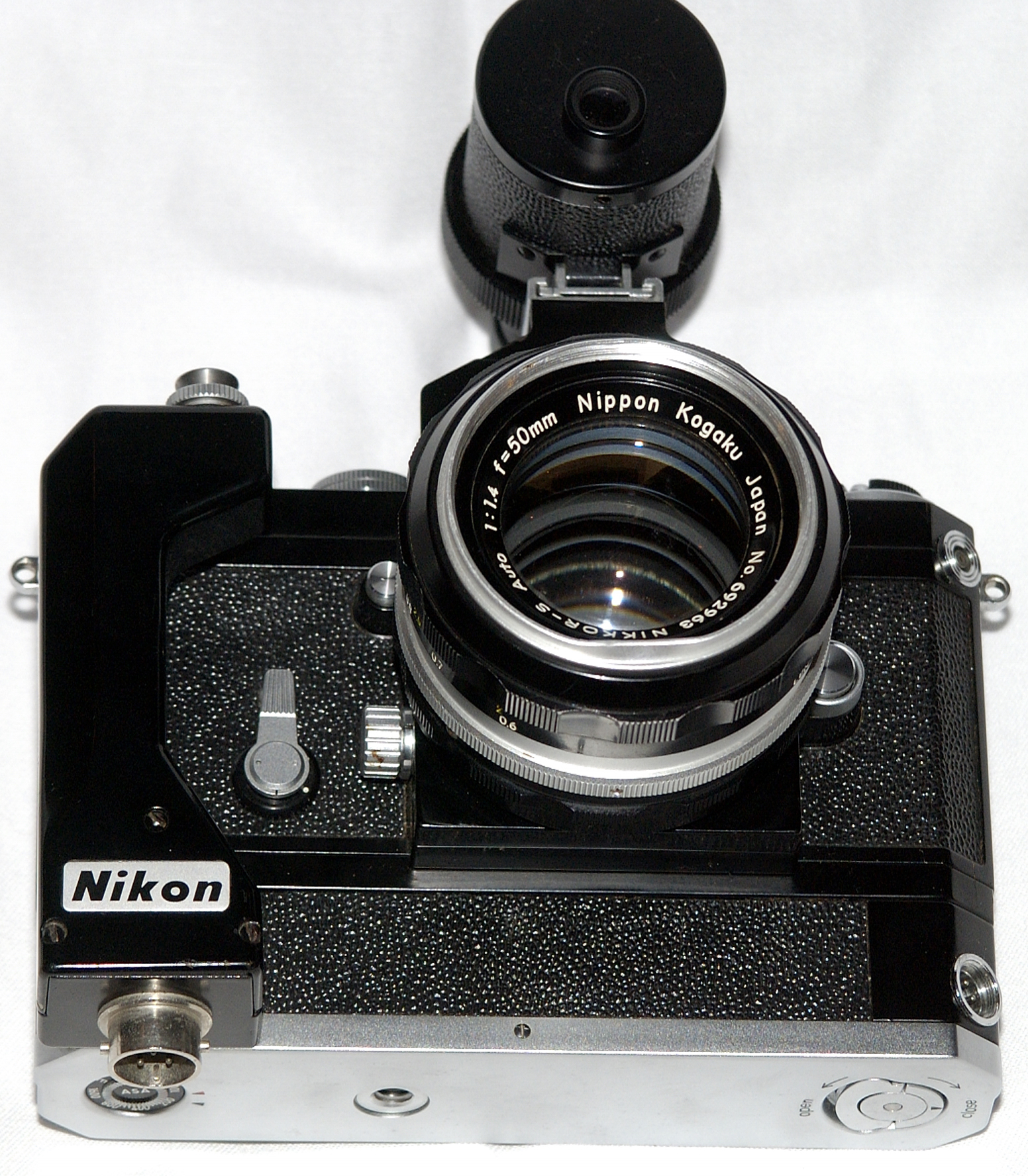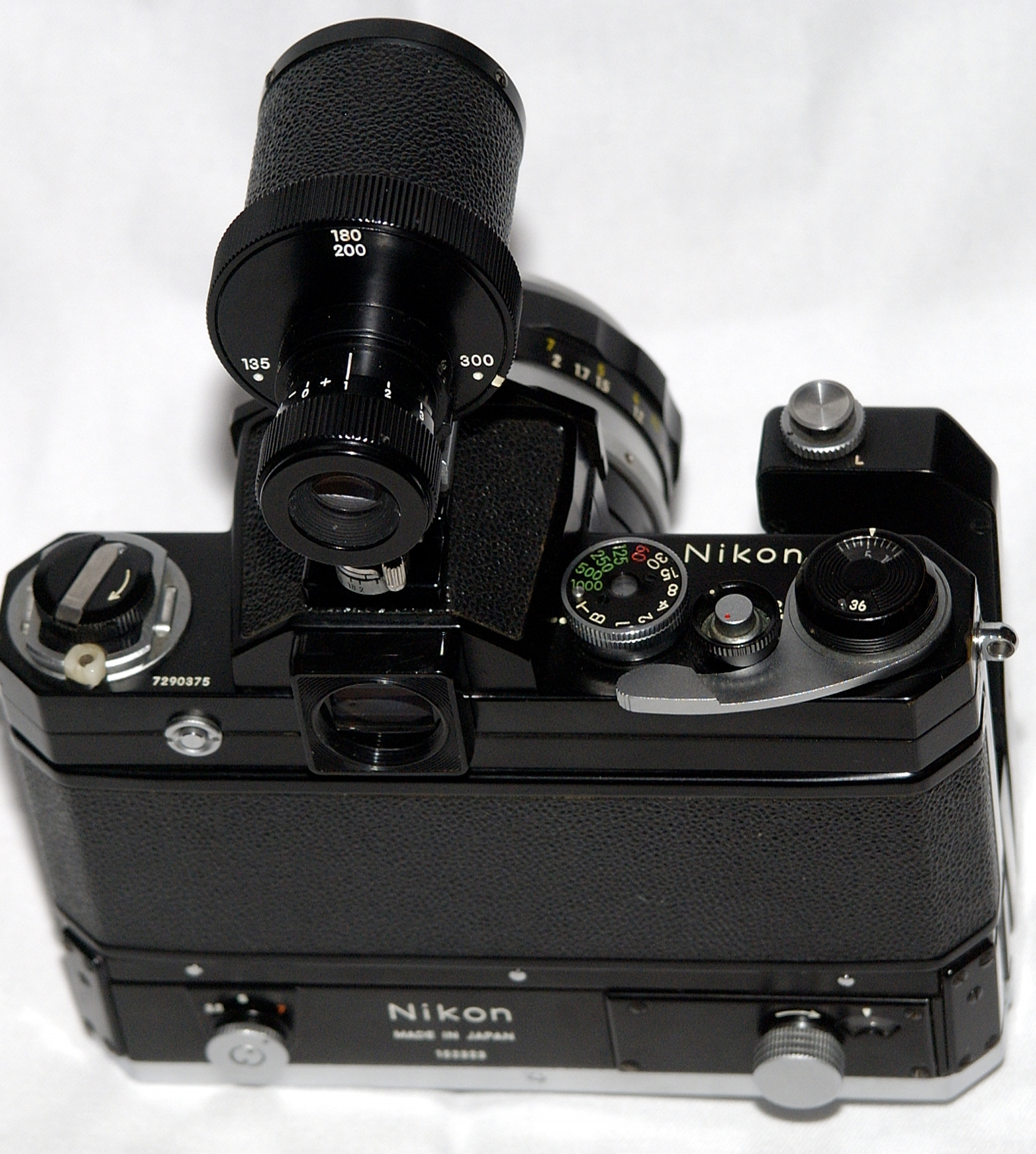Nikon FThe first professional single lens reflex camera of Nikon Corporation was introduced early 1959. Nikon F with plain prism and very early Nikkor-S 1.2/55mm. (lens no. 10 !)
In March 1959 Nippon Kogaku K.K., as Nikon Corporation was called in those days, introduced its first single lens reflex camera. It was designed by Nikon's chief designer, Mr. Masahiko Fuketa, who was also responsible for the design of Nikon's rangefinder cameras. The latter is patently obvious if we put both the Nikon SP and the Nikon F side by side (see picture below). Many parts are identical and even exchangeable. The layout of the Nikon F comes close to that of the Nikon rangefinder cameras. In fact the Nikon F is a rangefinder camera where the rangefinder, the lens mount and film chamber has been replaced by a detachable viewfinder, F-lens mount and a mirror house. The shutter and the back&bottom combination remained almost unchanged. The introduction of the Nikon F was a very good shot by Nikon. The camera is a genuine system camera. Backs, motor drives, viewfinders, focusing screens and lenses can be exchanged. Over the years of its manufacture (one million cameras were produced between 1959 and 1973) the camera did not change significantly; apart from some internal parts. Professional photographers became accustomed to its durability, versatility and dependability. The lens mount, nowadays called 'F'-mount - as a commemoration to the late Mr. Fuketa - has shown to be one of the best technical innovations in camera history. After nearly 60 years it is still in use on the latest Nikon cameras. No other camera manufacturer can offer this. To find out when your camera was produced see the Nikon F serial number matrix.
Nikon F and Nikon SP bearing many resemblances (courtesy Jan Prinsen)
All camera models and most accessories could be ordered in chrome or black paint The first Nikon F's were supplied with the eye level prism finder (see picture above), having no metering components. The first eye level finders have a square viewing port, later models have a round viewing port. To mount accessories like eyepiece correction lenses on the square viewing port, an eyecup adapter has to be attached first. Later Nikon offered an action finder (aka Sport finder F) and a waist-level finder (both without an exposure meter) as well.
Metering with the first Nikon F was only possible with a clip-on external selenium meter (see picture above). It couples with both the camera's shutter speed dial and lens aperture. On top of the meter exposure information can be found. In April 1962 Nikon introduced the first Photomic prism (see pictures below): an eye level prism finder with a CdS (cadmium sulfide) external cell but no TTL = trough the lens metering. Via a Light Acceptance Converter Tube and Incident Light Opal Plate metering is taken place. This meter is coupled to the shutter speed dial and aperture ring. Correct exposure is set by centering the meter needle visible in the viewfinder, by turning either the shutter speed dial or the aperture ring of the lens in use.
Nikon F with early Photomic model (viewfinder with built-in exposure meter, but without TTL-metering)
Nikon F with F Photomic Model II viewfinder: left diffuser alias tele-simulator screwed on top of the battery chamber lid (when not in use) and at the right it is screwed on the exposure meter's eye in case of back light or when a tele-lens is used.
Nikon F with later Photomic (TTL-) viewfinder, DL-1 viewfinder illuminator, flash shoe and Nikkor-H 2-50mm. TTL metering was - at long last - provided with the Photomic T finder, which was introduced in September 1965. This meter has 2 CdS cells with built-in condenser lenses to avoid back light entering from the eyepiece. It uses a match-needle system as described above. The Photomic T finder will not fit early camera bodies. Camera bodies with a serial number from 658xxxx - 66xxxxx have a red dot in front of the serial number added (see below) to designate those bodies that were modified to accept Photomic T and later finders. Collectors are very much interested in those 'red dot' Nikon F's, in such a way that fake bodies are offered at second hand markets. To check whether the body is genuine or not visit the very informative web site of Mr. Matthew Lin. Nikon F with red dot. The T-finder was improved and in April 1967 introduced as the Photomic Tn. The most important change was the center-weighted exposure metering. One year later (September 1968) the Photomic Tn was replaced by the Photomic FTn, featuring semi-automatic maximum aperture indexing and the display of the shutter speed setting inside the viewfinder. The Photomic FTn finder will fit all Nikon F models; for cameras with a serial number below 6900001 a small modification (Nikon nameplate should be slightly filed on the upper corners) needs to be made in order to attach this finder to the body. Flash photography was possible via a PC socket on the upper left front corner or via flash shoe (see above) which was put over the rewind crank. In front of the shutter speed selector a flash synchro-selector window indicates the synch by lifting and turning the ring around the shutter speed selector. This makes it possible to use bulb flashes and electronic flashes. The Nikon F has a shutter with speeds from 1 second up to 1/1000 sec. Bulb flash sync was up to 1/1000 sec.; electronic flash sync up to 1/60 sec. The F-36 Motor Drive and the F-250 Motor Drive could be attached after a tiny modification (motor drive plate at the inner base of the camera body has to replace the standard plate). Many photographers, scientists (from archeologists to zoologists), researchers, soldiers etc. used and modified their Nikon F for their specific use. Many manufacturers, other than Nikon Corporation, produced a great variety of accessories for very special photographic assignments. This camera was and still is very popular among photographers and collectors. The serial numbering started at 6400001. Camera's with early numbers are very much wanted and are gaining high prices at auctions. Via the Nikon Historical Society information can be obtained of the oddities and rarities among various Nikon F versions and their accessories.
Below a 'naked' Nikon FThis naked Nikon F body is the basic body which can be 'dressed' with various viewfinders, backs, motor drives, finder screens, etc. For collectors some points are of special interest. 1. Serial number. Numbering started at #64xxxx1 (7 digits). Very early models are very much wanted. Bodies with a red dot in front of the serial number (#65 or #66 - see above) are interesting too. 2. The engraving of the manufacturer 'Nippon Kogaku Tokyo' , 'Nikon' or 'Nikkor' on top of the body may be of interest as well. Camera bodies up to #676xxxx may have 'Nippon Kogaku Tokyo' (as shown in the picture), later models will have 'Nikon' engraved. A rare number of chrome and black bodies, probably numbered from #68xxxx and up, show the engraving ''Nikkor'. These rare models were marketed in Germany and Switzerland. It was the result of a deal Nikon Corporation made with the German camera manufacturer Zeiss-Ikon as the latter was afraid for name confusion. 3. Various buttons, levers and engravings may differ. 4. Also the lever of the self timer may differ. Collectors do care for the authenticity of a certain model with a specific serial number. To discover whether a camera, its serial number and general outfit is fake or not does influence the value of a camera. It is possible - however - that the former owner/user may have put later accessories on an early body or vice versa.
In the early 1970's some special Nikon F models were produced. Photographers at the Olympic Winter Games 1972 in Sapporo, Japan, had the possibility to use a Nikon F High Speed, enabling to shoot at speeds up to 7 frames per second! Above you'll see the (front of) Nikon F High Speed Sapporo with the motor drive and the connector for an external power pack. On top of the camera a special view finder is mounted for the use of several tele-Nikkor lenses. As the camera mirror has to be locked up by those high speeds this view finder is an essential part of this set.
For photographers at the 1974 Olympic Winter Games in Montreal (Canada) a slightly modified version of the Nikon F High Speed was introduced. Most important feature is the 9 frames per second top speed! Other special models of the Nikon F are the Nikon F Hand-Fundus camera, used by ophthalmologists. These cameras have a higher view finder, a built-in flash (connected to an AC-unit), a very special lens and a pistol grip. The Nikon Screen camera has a special body enabling to look through 16 different view finder screens, that were available for the Nikon F. This camera has a lens mount, a locked mirror and view finder, but no film can be loaded. For special clients (e.g. NASA, US Navy, US Air force) special models were made. Now and than some very rare Nikon F based cameras come to surface. Nikon F 'Apollo'
At the end of its production period the Nikon F (from #73xxxxx) was fitted with a plastic tip on the advance lever and the self timer, like the Nikon F2 has. It also have a threaded flash connector. Many collectors are calling these Nikon F's 'Apollo', referring to the NASA space program. Nikon F Apollo are much wanted among collectors.
|



